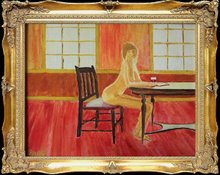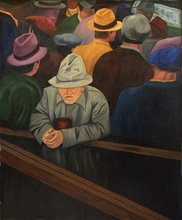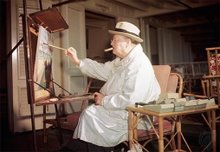
(White Dress)
6 X 6 inches
Oil on wood panel.
Lady of Beauty Series
The paintings will be done from photographs, and live models when possible. So if anyone is interested in becoming a lady of beauty, let me know.
The two (depending on your viewpoint) famous or infamous paintings are mentioned in the story about Agnes.
Here is some information from, www.agnes.com, regarding her life.
Following the Black Plague of 1348, which killed a third of the population of Europe, a stable and prosperous period reigned. People took advantage of the pleasures of life. The Renaissance allowed people to glorify life, and specially, to glorify the beauty of the female body. Erotic paintings, by Renaissance standards, represented noblewomen with low necklines set off with high (and tight) belts.
It was then that Agnes Sorel (1422 – 1450) became the first queen of fashion and luxury. As one of the “concubines of the Renaissance monarchs” – she was the mistress of Charles VII of France – Agnes became the first royal favorite among the people of France. She played an important political role and exerted an invigorating influence on the king. It was Agnes who encouraged Charles VII to help Joan of Arc battle the English.
Agnes became famous for a painting, by the French painter Jean Fouquet (c. 1420- c. 1481), which shows Agnes with one breast uncovered, a surprising indiscretion, with an infant. The painting was called Virgin and Child. One century later, an anonymous painter portrayed Agnes Sorel in the same pose; this time, the child was missing. This was particularly erotic because the painting gave the impression of Agnes undressing. And so, Agnes may have launched the extravagant fashion of one breast in, one breast out, in the paintings of the time.
In the mid-19th century, Agnes became the first woman ever to be allowed to wear diamonds, which were extremely rare and greatly valued. The gem was deemed so precious that women were forbidden – by law – to wear or posses them. During this period, only princes, kings and emperors wore the precious gem because it held a symbol of power, courage and virility. But love and desire made shambles of the law. You see, like most women, Agnes loved diamonds and wanted to wear as many as she could lay her hands on. And because the king was as fascinated by Agnes as he was by the precious stone, the law was conveniently forgotten.
Although she died at age twenty-eight, Agnes became the symbol of beauty, luxury and intelligence. Agnes Sorel was a decidedly erotic madonna. Unfortunately, with Agnes we have only a half-legendary story: Rumor has it that Agnes was poisoned by Jacques Coeur (1400-56), an alchemist who circulated counterfeit gold and money with King Charles VII (1403-61). This, however, was never confirmed nor denied.









No comments:
Post a Comment